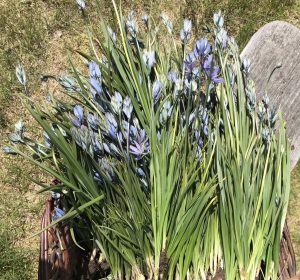 May Day! This Wednesday, we dedicated our thirteenth Ethnobotany Apprenticeship class to the camas lily and its roots. Imagine the importance of this vital source of carbohydrates to native people living here for thousands of years: Years before we could buy the carbo-centric cornucopia of foods in supermarkets and fast food chains. We traveled to the Mima Mounds Natural Area Preserve where Blue Camas or Camassia quamash decorates the grasslands. The Mima Mounds are a curious landscape of low, domelike, natural mounds that seem to be erupting from the earth. Studies theorize that they were formed as the result of glacial movement.
May Day! This Wednesday, we dedicated our thirteenth Ethnobotany Apprenticeship class to the camas lily and its roots. Imagine the importance of this vital source of carbohydrates to native people living here for thousands of years: Years before we could buy the carbo-centric cornucopia of foods in supermarkets and fast food chains. We traveled to the Mima Mounds Natural Area Preserve where Blue Camas or Camassia quamash decorates the grasslands. The Mima Mounds are a curious landscape of low, domelike, natural mounds that seem to be erupting from the earth. Studies theorize that they were formed as the result of glacial movement.
Karen’s friend Cindy invited us to harvest the plants. Cindy has been hosting Earthwalk students for many years. We were grateful for her warm welcome and the sunny green pastures lush with camas surrounding Cindy’s home. 
Karen taught us to unearth the roots in the way that indigenous peoples did in the past: using cupins or traditional digging sticks. 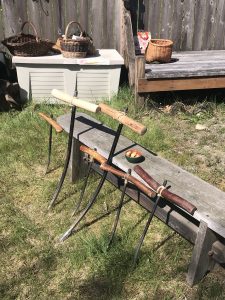 Rather that being over harvested, digging the roots in this way aerates the soil and frees the camas plants from becoming entrapped in the matting of other grasses.
Rather that being over harvested, digging the roots in this way aerates the soil and frees the camas plants from becoming entrapped in the matting of other grasses.
Pacific Northwest native people cultivated camas plots that were maintained and harvested by kin-groups who served as plant stewards.
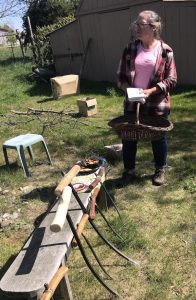 Karen affirmed our intention and drew inspiration from Robin Wall Kimmerer’s book Braiding Sweetgrass:
Karen affirmed our intention and drew inspiration from Robin Wall Kimmerer’s book Braiding Sweetgrass:
“Know the ways of the ones who take care of you, so that you may take care of them.
Introduce yourself. Be accountable as the one who comes asking for life. Ask permission before taking. Abide by the answer.
Never take the first. Never take the last. Take only what you need.
Take only that which is given.
Never take more than half. Leave some for others. Harvest in a way that minimizes harm.
Use it respectfully. Never waste what you have taken. Share.
Give thanks for what you have been given.
Give a gift, in reciprocity for what you have taken.
Sustain the ones who sustain you and the earth will last forever.”
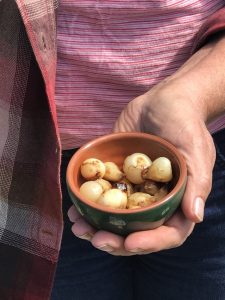 Karen offered us a slightly sweet, starchy camas “potato” prepared by last year’s students. She explained that they were pit-roasted for a day in order to break down the difficult to digest inulin fibers. We will be preparing bulbs for next year’s EarthWalk ethnobotany students.
Karen offered us a slightly sweet, starchy camas “potato” prepared by last year’s students. She explained that they were pit-roasted for a day in order to break down the difficult to digest inulin fibers. We will be preparing bulbs for next year’s EarthWalk ethnobotany students. 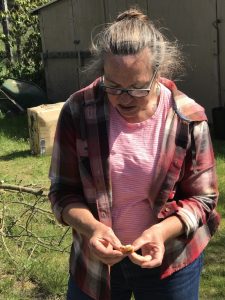 Native people dried the bulbs and pounded them into flour or cakes which could easily transported throughout their extensive trade network. (For a fascinating read on this process you can read Madeline Ostrander’s HaiKai Magazine article The Local Carb Diet. It includes a re-enactment of the pit burning process.)
Native people dried the bulbs and pounded them into flour or cakes which could easily transported throughout their extensive trade network. (For a fascinating read on this process you can read Madeline Ostrander’s HaiKai Magazine article The Local Carb Diet. It includes a re-enactment of the pit burning process.)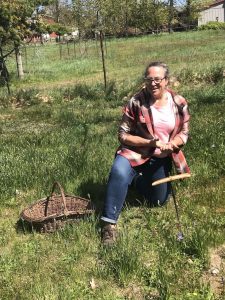
To begin harvesting, Karen made an offering of herbs from the beaded rawhide pouch she made under the guidance of her Cherokee mentor many years ago. She demonstrated how to harvest the roots and cautioned us to keep the blue flowers attached so we could distinguish between blue camas and the toxic white-flowered death camas. We will replant any detached bulbs for next spring’s harvest. 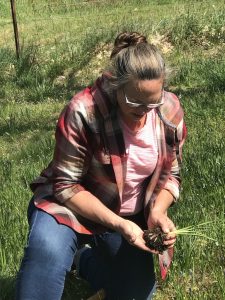
I was moved by the gentle way she loosened the soil and freed the bulbs rather than pounding and pulling (the way I’ve often approached gardening!) This reminded me that I’m working with a friend and ally.
It was wonderful to spend an afternoon in the sun with my hands in the earth. Many hands lighten the “work” and season the time with good feeling. 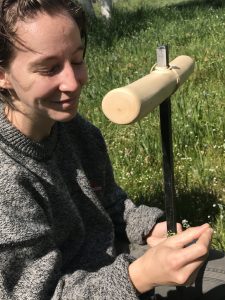 Sometimes I get a taste of clan or tribe “spending” time this way. Spending or giving? It was more like a quiet unfolding. The relationship Cindy and Karen have nurtured with these fields seems characterized by deep appreciation, caring and joy. I feel changed.
Sometimes I get a taste of clan or tribe “spending” time this way. Spending or giving? It was more like a quiet unfolding. The relationship Cindy and Karen have nurtured with these fields seems characterized by deep appreciation, caring and joy. I feel changed. 
